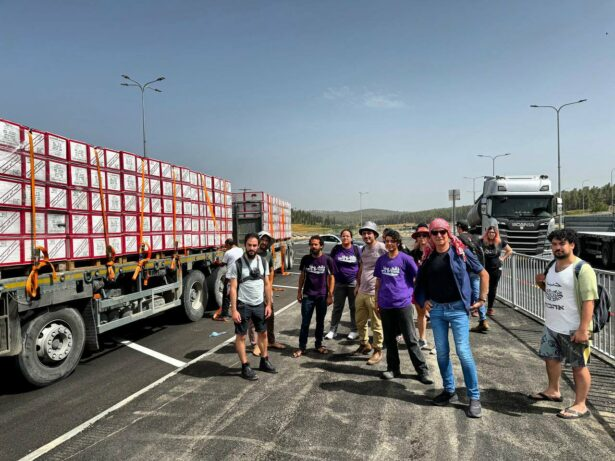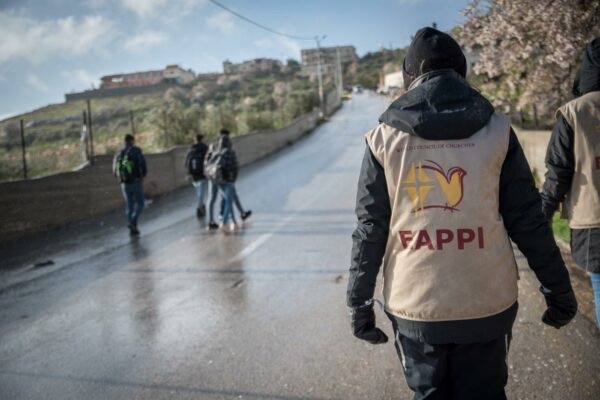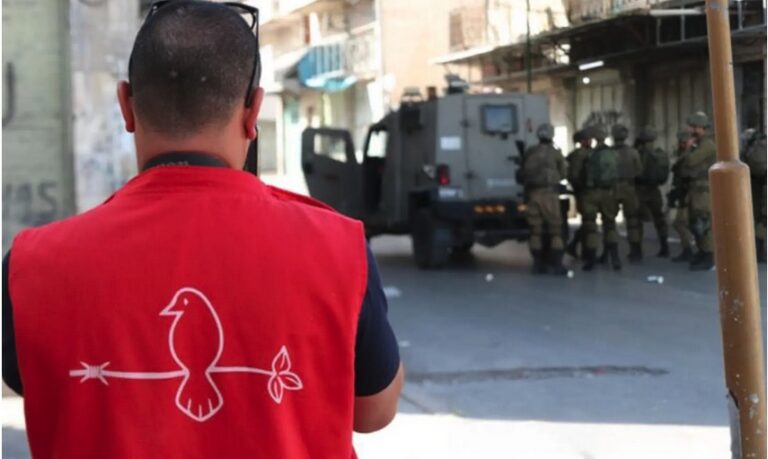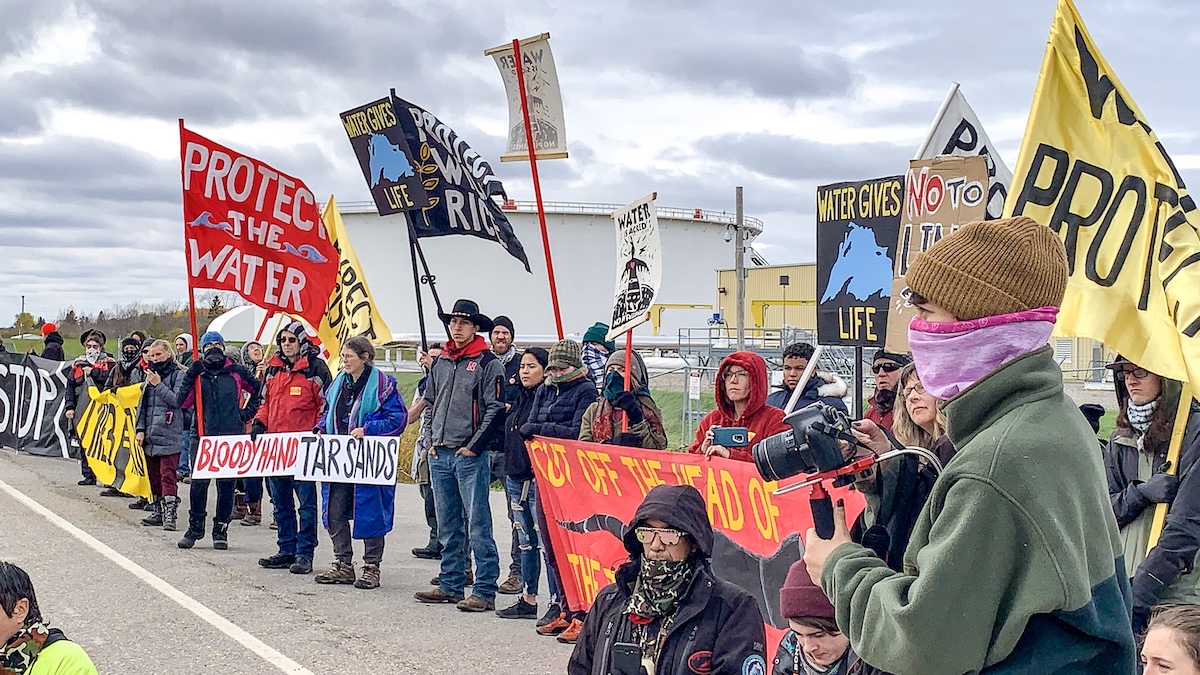By Mel Duncan for Waging Nonviolence
When the U.N. Security Council finally passed a Ceasefire Resolution for Gaza by a vote of 14-0 — with the U.S. abstaining — on March 26, it was clear in its demand for a ceasefire, as well as several other key points, including the unconditional release of all hostages, the proper treatment of detainees in compliance with international law and access to humanitarian and medical aid. However, the UNSC was silent about how these demands might be enforced, thus rendering them more akin to suggestions.
That same day, an advance draft of a U.N. Human Rights Council report offered a glimpse at how such enforcement could actually happen, calling for the deployment of “an international protective presence” to help stem violence against Palestinians in Gaza and the rest of the Occupied Territories. The following day, the report’s author — Special Rapporteur Francesca Albanese — expanded on her recommendation at a news conference in Geneva, saying that such an international protective presence should operate like the handful of NGO-affiliated unarmed civilians currently interposing themselves on the West Bank and in East Jerusalem. “This is the thing that should be done,” she explained. “Making sure that pending the military withdrawal from the Occupied Territories, there is a shelter between the Palestinians and the armed settlers and army.”
Albanese is correct: Now is the time to recruit, prepare and send large numbers of well-trained unarmed civilian protectors to the Occupied Territories of Palestine to support local civil society, directly protect civilians and bolster those already providing unarmed civilian protection on a small scale. While the U.N. Security and Human Rights Councils have created openings, we cannot wait for them to act. The Security Council could take months — if ever — to make a decision, and even then, it would be prone to send armed peacekeepers. Unarmed civilian protection and accompaniment groups have, for years, been successfully carrying out the activities described by the UNSC and HRC. We must accelerate this people-to-people response.

As Special Rapporteur Albanese noted, Israeli, Palestinian and international groups have already been providing unarmed civilian protection, or UCP, in other parts of Palestine. Facing intensified harassment and violence from settlers and the Israeli Defense Forces since Oct. 7, groups like Ta’ayush, Looking the Occupation in the Eye, the Center for Jewish Nonviolence and Community Peacemaker Teams continue to provide protective presence and support self-protection in the homes of Palestinians and at checkpoints, as well as by accompanying farmers and shepherds.
Recently, in response to Israeli settlers blocking a Gaza aid convoy arriving from Jordan at the Tarqumiya checkpoint, the Jewish and Palestinian grassroots movement Standing Together mobilized a Humanitarian Guard to accompany trucks carrying aid destined for Gaza. “There is always the risk that something physical might happen, of course, but engaging with the settlers is not our goal,” Rula Daood, the national co-director of Standing Together told Haaretz. “Instead, we not only want to call attention to what is happening at the border crossing, we hope that our presence there will bring accountability to the police and the army.”
On May 19, the Humanitarian Guard was able to block the settlers from the convoy at Tarqumiya checkpoint, with the police arriving promptly to move the settlers back. The group again helped remove settlers when they attacked the trucks at another junction. “Up to now all the food that went out today will get to Gaza safely,” a Standing Together spokesperson reported. They will be going out every day to protect the trucks from settler attacks.
Haaretz recently reported on the stories of six Israeli activists who are trying to protect Palestinians in the West Bank. Hillel Levi Faur is part of a group of about 100 young people called Presence in Hard Times, which places Israelis in homes under threat in the South Hebron Hills. As Levi Faur stressed, “They keep pleading with us to come. There are communities that make you feel bad if you don’t show up for a week or two. They say, ‘We can’t sleep.’ It’s terrible, having those conversations.”
As part of her work for the Center of Jewish Nonviolence, Katie Loncke reported similar examples of deterrence through protective presence during her stay in Masafer Yatta, citing shepherds who were able to extend their grazing areas and a family that was able to return to their home.
The 2016 study “Wielding Nonviolence in the Midst of Violence” found multiple respondents reporting positive impacts of unarmed civilian protection in the Palestinian territories, including enhancing Palestinian leadership and nonviolent resistance, helping people keep land and stay in their communities, decreasing violence toward Palestinian demonstrations, de-escalating violence by Israeli soldiers, decreasing violence by Palestinians, protecting school children and decreasing checkpoint abuse. According to the study’s findings, “Respondents consistently reported that UCP activity has diminished violence from soldiers, settlers and Palestinians.”
The good news is that those already active groups are scaling up their efforts. The Center for Jewish Nonviolence is recruiting individuals to join 10-day Summer Solidarity Shifts to bolster the existing network of solidarity presence. The Italian group Operazione Colomba is continuing to support the nonviolent struggle of the Palestinian communities south of Hebron, and the U.S. group Meta Peace Team is gearing up to send a team. Meanwhile, accompaniers from the World Council of Churches-sponsored Ecumenical Accompaniment Programme in Palestine and Israel are returning to their work in the West Bank.

The opportunity
While the existing work is extremely important, it will have to be significantly scaled up in numbers and duration to address the needs of not only the West Bank, but especially Gaza. Fortunately, the human resources exist. Hundreds of veteran unarmed civilian protectors and accompaniers live in at least 35 countries and have worked with one or more of the 60-plus organizations practicing UCP and accompaniment. At least 20 of these organizations have already worked in the Occupied Territories of Palestine.
With sufficient funds (a fraction of the cost of any military intervention), they could be mobilized, provided updated training by Palestinians and deployed quickly. Working closely with local Palestinians and UCP groups on the ground, these veterans could effectively carry out the objectives in the Security Council Ceasefire Resolution and Human Rights Council report, including:
- protecting efficient provision of humanitarian assistance and medical care,
- accompanying people under threat,
- interpositioning between conflicting parties,
- monitoring ceasefires,
- monitoring and reporting on compliance with international law, and
- providing direct protection to civilians.
Previous Coverage on Waging Nonviolence
There’s a better way to make communities safer — and it’s taking off around the world
Peace Brigades International, for example, has been providing accompaniment to vulnerable people in Colombia among other places since 1994. The organization I helped to found, Nonviolent Peaceforce, has been opening humanitarian access for remote, difficult to reach places in South Sudan since 2011. The Swedish Fellowship of Reconciliation is among many UCP groups that — in addition to providing accompaniment and protective presence, as well as supporting communities in self-protection — monitors and reports on international law, for example arbitrary detentions in Mexico.
Nonviolent Peaceforce was also part of the ceasefire process in Mindanao from 2009-2014, having been invited by both the government of the Philippines and the Moro Islamic Liberation Front to be an official part of the International Monitoring Team. Reflecting on her work with my former organization in Mindanao, Ambassador Kristine Leilani R. Salle from the Philippine Mission to the U.N. in Geneva said: “Our experience shows that civilian-led nonviolent approaches can contribute to saving lives and empowering people in communities to build a just and lasting peace for themselves even under the most difficult of circumstances.”
These veterans of UCP and accompaniment also have experience in applying a variety of other nonviolent methodologies, including de-escalation, early warning/early response and supporting community-based unarmed self-defense. What’s more, they have extensive experience dealing with armed actors — whether they be warring governments or non-state actors like the Tamil Tigers in Sri Lanka, the Moro Islamic Liberation Front in the Philippines or the FARC in Colombia. Their goal is not to convert anyone — although sometimes that happens — but rather to be able to communicate with one another, lessen tensions, protect civilians and prevent violence.
Violence as default
Despite the success stories cited above, many policy leaders are once again poised to spend billions of dollars for an armed peacekeeping approach in the Occupied Territories. On May 16, the Arab League passed the “Manama Declaration,” calling for U.N. peacekeeping forces to be sent to the occupied Palestinian territories until a two-state solution to the Israel-Palestine conflict is implemented. This comes at the same time as the U.N. is withdrawing 13,500 peacekeepers from Democratic Republic of the Congo at the demand of the Congolese government, which says the peacekeepers have failed — after 20 years — to protect civilians from armed groups.
While armed peacekeepers can often keep other armed groups apart, they are neither trained, equipped nor good at community engagement, which is essential for protecting civilians and building sustainable peace. Military peacekeeping forces are usually drawn from South Asian or African militaries — with their governments being paid for the service. They typically do not speak local languages and are not allowed to live in the community. Therefore, they only have limited interactions with civil society.
Working with Nonviolent Peaceforce, I saw U.N. peacekeepers’ lack of on-the-ground engagement in South Sudan. I even unsuccessfully advocated — with the U.N. Department of Peacekeeping — for their armed peacekeepers to protect women from assault by walking with them as they collected firewood in the bush. I was told that it would be too unsafe. This is something our unarmed teams did routinely for four years.
Because armed peacekeepers have limited engagement with local civil society which is a fundamental element in protection, the best they can offer is an imposed, temporary, top-down intervention. Rachel Julian of Leeds Beckett University observes in her forthcoming book on UCP, “Transforming Protection,” that such top-down, armed approaches to protection assumes expertise and power are in the hands of a few outsiders, excluding local agency. “This means that what safety means to them, the diverse nature of the threats and the transformational change required are not included. Transformational change requires a change in the power system,” Julian concluded.
Now is the time to act
With the attack on Israeli civilians by Hamas on Oct. 7 or the targeted killing of World Central Kitchen staff by IDF drones on April 1, it is fair to ask why unarmed civilian protectors would be treated any differently. However, it’s the international attention brought on by these very tragedies that may expand the protection internationals can provide. For example, in 1987, American engineer Ben Linder and two other humanitarian workers were killed by the Contras along the northern border of Nicaragua. His death elevated international outrage mobilizing hundreds of internationals to go Nicaragua, which in turn expanded a protective presence in rural areas.
While it is almost impossible for anyone to get into Gaza at the moment — let alone a large group — pressures are building rapidly with the growing recognition of Palestinian statehood, the International Criminal Court issuing arrest warrants, the International Court of Justice ordering Israel to abide by the Genocide Convention and ceasefire negotiations still ongoing. At the same time, on the grassroots level, students around the world are pressing for divestment from Israel, the Freedom Flotilla is pushing for entry into Gaza and groups like Jewish Voice for Peace are organizing for a ceasefire and an end to military aid to Israel.
These diplomatic, legal and grassroots initiatives will intensify and continue to create cracks if not openings. We have to be ready to take advantage of them when they occur. If we wait to prepare until the opportunities are fully formed, militaries will have already been deployed. By demonstrating our readiness, we build the reality and pressure to use UCP.
Acting as a consortium, UCP groups can bring together a large-scale, experienced, well-trained international force of unarmed civilian protectors who have proven that they can protect civilians, deter violence, accompany hostages, protect the delivery of humanitarian assistance, protect homes, support community self-protection and assist the implementation of ceasefires. They can work closely with local civil society to build lasting peace. To have this resource available now, will only speed up the peace process.


